Papers by Luis Albano Calabrano Hidalgo

Gestión en el Tercer Milenio, 2000
El presente estudio. define el problema de la -siguiente .manera: "¿Cuáles son los factores ... more El presente estudio. define el problema de la -siguiente .manera: "¿Cuáles son los factores de los grupos de trabajo universitario que impiden el desarrollo de equipos de trabajo en la Facultad de Ciencias Administrativas, de la Universidad Nacional Mayor de San Marcos y en el semestre 99-11?" El método que se utilizó para la ejecución del presente estudio fue el descriptivo-analítico. El estudio comprendió las bases 97 y 98 de las-Escuelas Académico Profesionales de Administración de Turismo, Administración de Negocios Internacionales y Administración de la Facultad de Ciencias Administrativas de la Universidad Nacional Mayor de San Marcos. La población está integrada por 735 alumnos. Se seleccionó el tipo de muestreo probabilístico aleatorio simple y la muestra comprende en términos de proporciones el 11 % d-el total de la población, con un margen de error del 5%. Para la recolección de los datos se utilizó como método la encuesta, siendo el instrumento el cuestionario. ...
Gestión en el Tercer Milenio, 2000
Gestión en el Tercer Milenio, 2000
Las empresas e instituciones educativas deben buscar la mejor manera de hacer frente a un context... more Las empresas e instituciones educativas deben buscar la mejor manera de hacer frente a un contexto cada vez más complejo no sólo por la competencia de otras instituciones, sino también por los cambios socio económicos profundos en el país lo que hace obligatoria la reflexión sobre cómo formular políticas de desarrollo equilibrado que garanticen su supervivencia lo cual puede ser apoyado en buena medida por la planeación estratégica.
Transplantation Journal, 2010

Human Immunology, 2015
ABSTRACT Aim The LABScreen single antigen bead (SAB) assay is routinely used for HLA antibody det... more ABSTRACT Aim The LABScreen single antigen bead (SAB) assay is routinely used for HLA antibody detection and allows for testing of multiple patient samples. Despite this, standard SAB assay is time intensive, taking 1.5–2 hr to perform, which is not optimal for urgent testing. Utilizing a multicenter study we compared the rapid optimized SAB (ROB) protocol (Liwski et al. ASHI 2014), with a 30 min turn-around time (TAT), to standard SAB LABScreen method. Methods Ten HLA labs (BCM, DCI, Edmonton, Halifax, Georgetown, Winnipeg, METC, PSBC, SWI, UPMC) participated in the study. Five ASHI 2014 AC-1 survey sera (AC 460-464) were tested in each lab with standard SAB LABScreen (SSL) vs the ROB protocol. Class I LS1A04 (lot 8) and class II LS2A01 (lot 10) HLA kits were used. Mean fluorescence intensity (MFI) values were collected. Protocols were compared with respect to the mean MFI, specificities reaching consensus (⩾90% labs; 2000 MFI cutoff) and coefficient of variation (%CV). Results HLA antibody reactivity patterns were similar between the protocols with an excellent MFI correlation (r2>0.99) and signal to noise differential. Average MFI was slightly reduced with the ROB protocol (by 5.0%). The number of specificities reaching consensus (⩾90% labs; 2000 MFI cutoff) was similar between protocols (97 SSL vs 94 ROB). When the ROB protocol cutoff was lowered to 1500 MFI, the number of consensus specificities improved to 99, including all 97 SSL specificities (Fig. 1). Importantly, the average %CV of raw bead MFI was significantly improved with the ROB protocol (ROB: 21.2+/−3.4 vs SSL: 34.4+/−5.6; p< 0.001; Fig. 2). A slight increase in background was noted with the ROB protocol (AC 462 serum) in some labs. However, this had no impact on antibody assignment and improved with one additional wash step. Conclusions ROB protocol reduces SAB LABScreen assay time by 70% and improves precision without compromising sensitivity or specificity. Implementation of the ROB protocol will expedite antibody testing in urgent cases and improve TAT for routine testing.

Human Immunology, 2013
Aim Our laboratory is moving from a tube to tray based flow cytometry crossmatch (FCXM). We inves... more Aim Our laboratory is moving from a tube to tray based flow cytometry crossmatch (FCXM). We investigated the use of a vacuum manifold rather than a flick wash (FW) to perform the wash steps. Methods Crossmatches were performed as previously described using the rapid optimized FCXM method (Liwski et al. ASHI 2011, abstract 45-P). Our laboratory adopted this method but used a vacuum manifold to remove the supernatant. This manifold has 96 height adjustable probes and is attached to a vacuum source, in this case the hospital’s central vacuum system. The probes were lowered into the wells and the supernatant was removed. The cell button was vortexed before adding the next wash. We tested this vacuum manifold wash FCXM method in parallel with the FW FCXM method with 2 different cells. Negative serum (NS) samples as well as 4 dilutions of positive controls (PC) were included in these FCXM. The lymphocytes were isolated using the StemCell™ EasySep™. Reproducibility was evaluated based on the standard deviation (SD) of 14 duplicates for each wash method. The median channel values (MVC) shifts for T and B cell FCXM were also determined for each PC dilution in each wash method by subtracting out the NS value. Results The SD of the vacuum washed duplicates was 4.4 vs. 8.9 in the FW. The MCV shift was 1.8-2.0% more sensitive in the vacuum washed FCXM.[figure1]Fig. 1: T and B cell MCV shifts in vacuum vs wash FCXM trays. Conclusions The vacuum manifold wash method for tray based FCXM assay was as least as effective and reproducible as the FW method. The vacuum manifold also avoids the creation of potentially hazardous aerosols in the laboratory. We have adopted this method for performing FCXM wash steps.
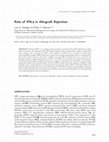
Critical Reviews™ in Immunology, 2002
Interferon (IFN)-γ is a cytokine produced mostly by activated T cells and NK cells that has compl... more Interferon (IFN)-γ is a cytokine produced mostly by activated T cells and NK cells that has complex effects on immune and nonimmune cells. IFN-γ plays important roles in inflammation, usually in synergy with other cytokines, such as IL-1β and TNF-α. The uniqueness of IFN-γ lies in its ability to induce major histocompatibility complex (MHC) expression in many tissues, making it particularly relevant to transplantation. The results of graft rejection in the absence of IFN-γ show that IFN-γ modulates but is not essential for the allogeneic responses, suppressing generation of CTL. In vivo IFN-γ has a protective role early in the response to vascularized organ allografts: transplants in mice have a tendency to develop necrosis when IFN-γ is not available, apparently by failure of the microcirculation. The lack of IFN-γ greatly reduces the induction of MHC in organ allografts, and it is possible that this is indirectly related to the protective effect of IFN-γ. Nevertheless IFN-γ also promotes graft vessel disease later in the course of the transplant. Thus IFN-γ has diverse and potentially contradictory effects on organ allograft survival, acting both on the immune system and on the graft itself, the net effect depending on the graft type and the time post-transplant.

Human Immunology, 2014
Aim We examined the relationship between Luminex single antigen bead (LSAB) MFI values and flow c... more Aim We examined the relationship between Luminex single antigen bead (LSAB) MFI values and flow cytometry crossmatch (FCXM) interpretation according to variable number of target antigens on the cells tested. Methods Sera ( n = 4) with select high reactivity to Aw4/Bw4, Bw6, or A2 CREG specificities alone (no class II reactivity) were selected. Sera were serially diluted (8-fold) up to 1:4096. Dilutions were analyzed by LSAB and FCXMs using PBL from individuals ( n = 14) with variable number of targets pertaining to the specificity of each serum (⩾3 PBL/serum). PBL class I antigen density was measured using W6/32. Results LSAB MFI values from serum dilutions highly correlated to the median channel shift (MCS) obtained against all cells tested ( r > 0.955). Comparing MCS from PBL with 1 target vs 2, we consistently observed an increase in MCS for each of the 4 sera ( Fig. 1 ). The % increase in MCS was higher using a 1:8 dilution when compared to neat. Only one serum was tested against pbl with 3 targets and another serum against PBL with 4 targets. In general, the trend was with increased MCS with increased number of targets. The number of target antigens on the PBL tested affected the overall FCXM interpretation. At high dilution ratios (1:64), the top bead MFI for the epitope (Bw4) was 2633 (median 1483 for all Bw4 containing beads) and interpretation varied between T and B neg results to T and B pos results with increasing number of targets (Table 1). Although class I antigen density also translated into increased MCS values, the increases were less than those observed with increased number of targets. Conclusion Our data suggest that accurate FCXM prediction requires knowledge of the epitope reactivities in a serum and the number of targets on the cells tested.
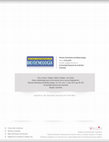
Revista Colombiana de Biotecnología, 2014
La vacuna Heberpenta-L, está indicada para la inmunización activa contra la difteria, tétanos, to... more La vacuna Heberpenta-L, está indicada para la inmunización activa contra la difteria, tétanos, tos ferina (pertussis), hepatitis B y Haemophilus influenzae tipo b. En el Centro Nacional de Biopreparados se diseñó una nueva planta de producción de productos parenterales, resultando la vacuna pentavalente uno de los productos recién introducidos. Con tal propósito se diseñó una nueva metodología para la formulación de la vacuna, adecuando los procedimientos normalizativos de operación vigentes a esta nueva instalación. La validación con medio de cultivo caldo triptona soya, resultó una de las etapas más importantes para garantizar, tanto las operaciones de esterilización y enfriamiento de las soluciones, como todos los pasos críticos en la formulación y operaciones asépticas para futuros productos. Se estableció una nueva metodología en el proceso de formulación para la preparación de las soluciones, la cual tuvo lugar en un área independiente al área de la formulación final del producto. Los resultados satisfactorios obtenidos en la formulación de tres lotes de consistencia de la vacuna Heberpenta-L, no solo garantizaron el cumplimiento de los requisitos de calidad establecidos para esta vacuna, sino que además constituyeron la base preliminar a largas campañas de otros productos.
Marine and Freshwater Behaviour and Physiology, 2003
Page 1. Mar. Fresh. Behav. Physiol., September 2003, Vol. 36, No. 3, pp. 143–159 SIZE-SELECTIVE F... more Page 1. Mar. Fresh. Behav. Physiol., September 2003, Vol. 36, No. 3, pp. 143–159 SIZE-SELECTIVE FORAGING BEHAVIOUR OF BLUE CRABS, CALLINECTES SAPIDUS (RATHBUN), WHEN FEEDING ON MOBILE PREY: ACTIVE ...
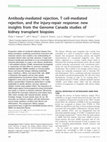
Kidney International, 2014
Prospective studies of unselected indication biopsies from kidney transplants, combining conventi... more Prospective studies of unselected indication biopsies from kidney transplants, combining conventional assessment with molecular analysis, have created a new understanding of transplant disease states and their outcomes. A large-scale Genome Canada grant permitted us to use conventional and molecular phenotypes to create a new disease classification. T cell-mediated rejection (TCMR), characterized histologically or molecularly, has little effect on outcomes. Antibodymediated rejection (ABMR) manifests as microcirculation lesions and transcript changes reflecting endothelial injury, interferon-c effects, and natural killer cells. ABMR is frequently C4d negative and has been greatly underestimated by conventional criteria. Indeed, ABMR, triggered in some cases by non-adherence, is the major disease causing failure. Progressive dysfunction is usually attributable to specific diseases, and pure calcineurin inhibitor toxicity rarely explains failure. The importance of ABMR argues against immunosuppressive drug minimization and stands as a barrier to tolerance induction. Microarrays also defined the transcripts induced by acute kidney injury (AKI), which correlate with reduced function, whereas histologic changes of acute tubular injury do not. AKI transcripts are induced in kidneys with late dysfunction, and are better predictors of failure than fibrosis and inflammation. Thus progression reflects ongoing parenchymal injury, usually from identifiable diseases such as ABMR, not destructive fibrosis.
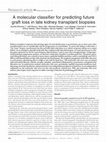
Journal of Clinical Investigation, 2010
Kidney transplant recipients that develop signs of renal dysfunction or proteinuria one or more y... more Kidney transplant recipients that develop signs of renal dysfunction or proteinuria one or more years after transplantation are at considerable risk for progression to renal failure. To assess the kidney at this time, a "for-cause" biopsy is performed, but this provides little indication as to which recipients will go on to organ failure. In an attempt to identify molecules that could provide this information, we used micorarrays to analyze gene expression in 105 for-cause biopsies taken between 1 and 31 years after transplantation. Using supervised principal components analysis, we derived a molecular classifier to predict graft loss. The genes associated with graft failure were related to tissue injury, epithelial dedifferentiation, matrix remodeling, and TGF-β effects and showed little overlap with rejection-associated genes. We assigned a prognostic molecular risk score to each patient, identifying those at high or low risk for graft loss. The molecular risk score was correlated with interstitial fibrosis, tubular atrophy, tubulitis, interstitial inflammation, proteinuria, and glomerular filtration rate. In multivariate analysis, molecular risk score, peritubular capillary basement membrane multilayering, arteriolar hyalinosis, and proteinuria were independent predictors of graft loss. In an independent validation set, the molecular risk score was the only predictor of graft loss. Thus, the molecular risk score reflects active injury and is superior to either scarring or function in predicting graft failure. Conflict of interest: The authors have declared that no conflict of interest exists.
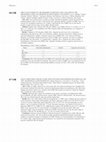
Human Immunology, 2010
Aim: MHC class I products serve as targets of cellular and humoral immunity in graft rejection bu... more Aim: MHC class I products serve as targets of cellular and humoral immunity in graft rejection but the immunoregulatory effects on CD8 T cells and NK cells expressing inhibitory receptors for MHC class I in rejection are incompletely understood. We sought to understand the role of MHC class Ia and class Ib products in graft rejection using a mouse kidney allograft model. Methods: Kidneys from wild-type (WT) B6 mice (H2b)(nϭ6) or H2Kb-/-Db-/-(nϭ5), or b2m-/-(nϭ5), or Qa1-/-(nϭ4) B6 mice were transplanted into CBA recipients (H2k) and histopathology was examined at 7 days post-transplant. Results: Compared to WT allografts, H2Kb-/-Db-/-allografts showed lower levels of interstitial inflammation and tubulitis but with severe peritubular capillary congestion and necrosis. Similar levels of interstitial inflammation, tubulitis, congestion and necrosis as H2Kb-/-Db-/-were observed with b2m-/allografts. To determine whether the protective effects of MHC class I molecules were direct or mediated through MHC class Ib products, we examined Qa1-/-allografts. Qa1-/-allografts also showed similar histopathology to that observed in H2Kb-/-Db-/-allografts including extensive congestion and necrosis of peritubular capillaries.
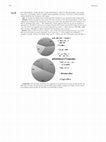
Human Immunology, 2011
To examine the changes observed following DTT treatment of sera assayed by single antigen beads. ... more To examine the changes observed following DTT treatment of sera assayed by single antigen beads. Methods: Positive screened sera were tested with class I (LSA1), nϭ94, and class II (LSA2), nϭ104, single antigen beads (LabScreen One Lambda Inc). All sera were tested with and without DTT. DTT treatment was done by incubating 90uL serum ϩ 10uL 50mM DTT. Volume added by DTT was not was not matched in untreated sera. The MFI of each bead was compared between DTT treated and non-DTT treated sera by paired t test. All results were manually reviewed and categorized as no effect, ϩ effect (increaseϾ1000 MFI), slight effect (increaseϽ1000 MFI), or diluted. Antibody (Ab) specificities were reviewed. Results: Effects of DTT are shown in Figure 1 and 2. Some beads showed marked increases (e.g.17,000) MFI but not all alleles increased consistently. Some of the class I ϩ effect samples were attributed to 'naturally occurring' Ab (E.g. Cw17/B76). Many class II ϩ effects were due to DQ beads, especially DQ7,
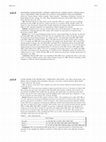
Human Immunology, 2011
Preformed and de-novo HLA donor specific antibodies (DSA) are a major risk factor of antibodymedi... more Preformed and de-novo HLA donor specific antibodies (DSA) are a major risk factor of antibodymediated rejection (AMR) and graft loss. Clinical outcomes are associated with the strength of DSA. We report two cases showing how dynamic DSA strength monitoring by Luminex-single antigen bead assay (L-SAB) provides important information for management of kidney transplant (Tx) patients. Methods: Sequential post-Tx sera were tested for HLA class I and II antibodies by L-SAB. DSA were determined by comparing with donor HLA typing. DSA strength was represented by normalized mean fluorescence intensity (MFI). Results: Case 1: A 53 year-old Hispanic female received a living related kidney Tx from her son. She had preformed DR4, DR53 and DQA1*03:01 DSA. She was transplanted with a positive B-cell flow cytometric crossmatch after desensitization treatment. At 3 months post-Tx , the patient had strong DR4 (MFI 9,069), weak DR53 (MFI 938) and DQA1*03:01 (MFI 1,278) DSA detected by L-SAB, elevated serum creatinine (Cr) at 1.8 mg/dL and AMR with strong and diffuse C4d staining in the allograft biopsy. She received IVIG and plasmapheresis therapy. The weak DSA DR53 and DQA1*03:01 disappeared and the strong DSA DR4 dramatically dropped MFI value to 2,940. Her serum Cr went back to normal. Case 2: A 39 year old African American male received a living unrelated kidney Tx. He had no pre-Tx DSA. De novo DSA against DQ7 (MFI 23,863) DQA1*04:01 (MFI 17,790) were accompanied with elevated serum Cr (2.6 mg/dL) and AMR with diffuse C4d staining in the allograft biopsy at 9 months post-Tx. Although the patient was treated with a similar protocol as case 1, neither the DSA MFI, nor the serum Cr decreased after 2 months. Splenectomy was performed to treat AMR. Conclusions: Although MFI value is not standardized, DSA MFI value is an important index to assess risk factors, to evaluate treatment response and to adjust treatment strategy for AMR. Dynamic monitoring of DSA strength by L-SAB aids clinical management in kidney Tx.
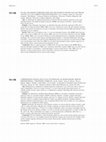
Human Immunology, 2011
To understand the additional information provided by NK cell transcript expression in late renal ... more To understand the additional information provided by NK cell transcript expression in late renal transplant biopsies with antibody-mediated rejection (ABMR) and biopsies from DSAϩ patients lacking microvascular lesions. Methods: Using Affymetrix microarrays, we identified transcripts selectively expressed in NK cells to assign NK cell transcript burden (NKB). NKB scores were calculated for each of the 403 clinically indicated biopsies from patients unsensitized at the time of transplant. Associations between NKB and histologic lesions and diagnoses were examined. Results: NKB scores were highest in late (Ͼ1 year post-transplant) biopsies with ABMR/ mixed rejection with a wide scatter in NKB scores. In contrast, NKB scores were not increased in biopsies with early ABMR. In late ABMR, NKB scores associated with microvascular inflammation lesions; glomerulitis and peritubular capillaritis, but not microvascular damage; transplant glomerulopathy, or interstitial inflammation. Biopsies from DSAϩ patients that lacked microvascular inflammation showed no particular association between NKB score and histologic lesions. However, NKB was associated with proteinuria in these patients suggestive of microvascular disease activity despite the lack histologic lesions. Conclusions: There is a high prevalence of NKB in late, but not early, biopsies with ABMR/ Mixed rejection with high variability in NKB scores. In biopsies from DSAϩ patients, NKB scores associate with an increased incidence of proteinurea; a functional marker of microvascular disease. Thus, NKB scores are indicative of microvascular disease activity when DSA is present in the recipient, translating into microvascular inflammation but not microvascular damage.
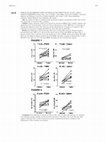
Human Immunology, 2011
To examine the effect of cryopreservation and pronase treatment on expression of HLA class I and ... more To examine the effect of cryopreservation and pronase treatment on expression of HLA class I and II on T and B cells as assessed by flow cytometry. Methods: Surface expression of HLA class I and II was assessed on PBMCs from 5 healthy volunteers and splenocytes from 5 deceased donors. Cells were frozen in the presence of 10% DMSO for 1-4 weeks prior to thawing and compared to fresh cells. Cells were treated with pronase for 15 minutes at 37 degrees C. HLA expression was assessed by staining with W6/32 for class I and L243 for HLA-DR. Results: Freeze/thawing of cells did not affect HLA class I or HLA-DR expression. Pronase treatment increased HLA class I MCV on T cells (pϽ0.023) and B cells (pϽ0.034) from PBMC and spleen (Fig. 1). Increases in HLA class I expression were most dramatic for T cells in PBMC and B cells in spleen. HLA-DR MCV was also higher in pronase-treated B cells from PBMC and spleen compared to untreated (Fig. 2). HLA-DR MCVs were quite low on T cells from PBMC and spleen and were excluded from analysis. Conclusions: Freeze/thawing of cells had no effect on HLA class I or HLA-DR expression. A commonly used technique; pronase treatment, showed increased expression of both HLA class I and-DR. Our results suggest a functional effect on HLA expression by pronase treatment that should be considered in the interpretation of flow cytometry cross-matches.










Uploads
Papers by Luis Albano Calabrano Hidalgo